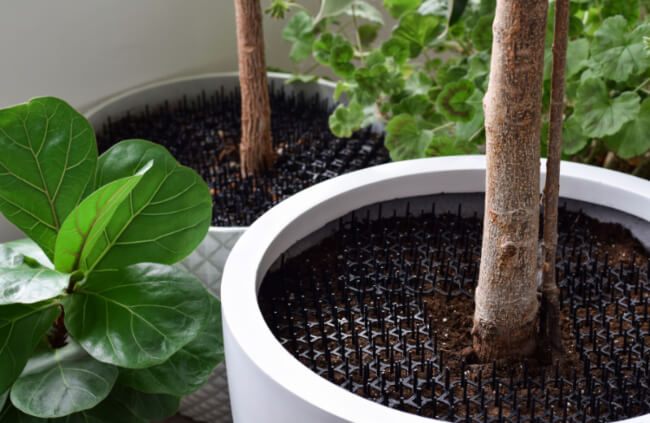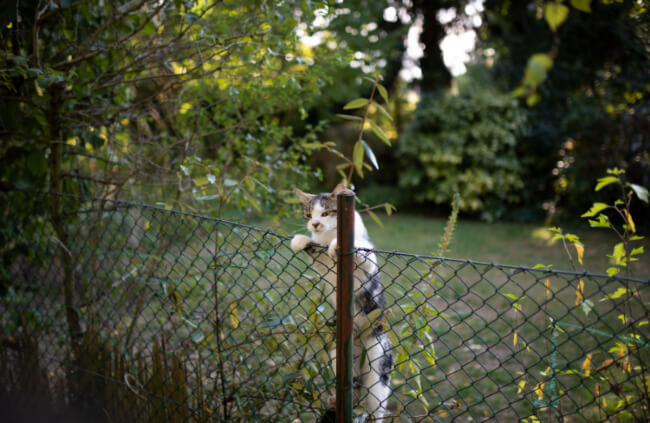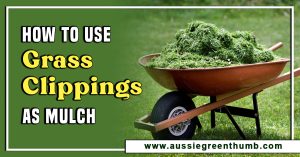Are you looking for ways on how to stop cats from pooping in the garden and sandpit? You can use physical barriers, chemical or natural deterrents or sound repellents. Along with these three methods, employ diversionary or preventive tactics to stop cats pooping in the garden.
Cats can turn areas of soft soil and newly planted seedlings in the garden into an outdoor litter box. In addition to the unpleasant odour, cat waste and urine may damage plants. Because cats are meat eaters, their faeces can harbour harmful pathogens passed on from birds, mice and other rodents.
In this article, we'll explore practical and proven strategies to help you reclaim your outdoor spaces. Say goodbye to unwelcome surprises and create a clean and pleasant environment for your garden and sandpit. Let's dive in and put an end to unwanted cat deposits once and for all.
More...
Ways to Stop Cats from Pooping in the Garden

Physical Barriers
Because cats look for soft, loose soil to dig in, put wire mesh poultry netting over the soil. Plant your seedlings through the holes in the mesh. Cats don’t like to walk over the wire and they find the wire impossible to dig through.
Additional barrier methods include placing large, flat stones around the plants or using pebble mulch around the plants. Cats don’t like to dig in small stones, and the large flat rocks will minimise the amount of exposed soil.
To stop cats from pooping in the garden, try to make the area as uninviting as possible by covering bare soil with materials such as sticky pinecones or thorny rosebush prunings, or insert upright sticks or plastic forks into the open spaces of the garden.
Use wire tomato cages around newly planted shrubs and trees to minimise cats’ access to the soil around the plant. As most cat owners know, felines dislike water and digging in wet soil. Keep the top layer of soil in the garden slightly damp to stop cats from pooping in the garden.
If you catch them digging, squirt them with a burst from a nearby garden hose or spray bottle filled with water to reinforce the lesson that they are unwelcome guests. Motion-activated lawn sprinklers can keep 24-hour vigilance and deter cats, along with other animals, from the garden.
Chemical Repellents
Commercial cat repellents, which contain the scent of predator urine from coyotes or foxes, are available to stop cats pooping in the garden. You can also try homemade repellents by using natural ingredients in scents that cats avoid.
Cut up citrus peels and sprinkle them through the area, or crushed lavender, rosemary and pennyroyal and spread it over the soil. Try spraying a solution of rosemary and water around the perimeter of the garden.
Cats seem to avoid the scent of both anise oil and eucalyptus oil, so you can soak cotton balls in these oils and place them throughout the garden. Reapply these repellents weekly or after a rainfall.

Sound Repellents
Gardeners with cat problems can try out an array of sound deterrents, from hanging up several sets of wind chimes in the garden to purchasing mechanical sound appliances. The sound of wind chimes in the garden may be enough to frighten cats from the area. If the cat becomes habituated to the wind chimes, you can try an ultrasonic repellent.
Motion activated, these devices emit a high-pitched sound at a frequency humans cannot hear when the cat comes within range. The noise frightens the cat, making it avoid the area in the future. Most ultrasonic repellents are battery operated for use away from electrical outlets, while others come with adapters for installation in locations closer to the home.
You can also employ diversionary tactics to stop cats pooping in the garden. Some cat owners suggest planting catnip in a bed or border far away from the garden. Other pet owners suggest setting up an outdoor litter box that you can clean at regular intervals.


Get Your Free Guide:
Master Growing Australian Natives eBook
A Must Have Complete Guide for Every Australian Garden
Get Your Free Guide:
Master Growing Australian Natives eBook
A Must Have Complete Guide for Every Australian Garden
Take preventative measures by sowing a green cover crop on bare soil over the winter. Cover newly tilled gardens and flowerbeds with heavy cardboard or newspaper weighed down with boards or rocks until you are ready to plant.
Motion Repellents
Another option, and one that has proved to work well, is to install a motion-activated sprinkler. Amazon sell this great motion-activated sprinkler that will only come on when an animal triggers its sensors. This will scare the living poop out of cats trying to defecate in your garden.
Keeping the Sandpit Free of Cat Faeces
Kids love sand. So do cats. And with all this love in the air one could assume that this is a partnership made in heaven. The problem is that your kids see the sandpit as a playground: the cat views it as a bathroom.
And Mum and Dad view those agendas as diametrically opposed – as they should. So, how do you keep your cat – or more likely, the neighbour’s cat – from treating the sandpit as an over-sized kitty-litter?
While one may assume that cat faeces is the worst offender there is another substance that spells death to the sandpit even more: cat urine. Once a cat has peed in your sandpit there is very little you can do to remove the smell from the sand. The only cure is time or gallons and gallons of water to help dilute it.
Which means that cat-proofing your sandpit is the only option. So, here are some ideas to help keep your sandpit free from these dreaded pets.
Install a sandpit cover
Whether it be made from canvas, PVC or even a hard-top, a sandpit cover should eradicate most of these problems. The issue then becomes maintaining the cover so that it continues to offer protection against cats and other pests.
If you’re thinking about installing a sandpit cover then consider one that forces rainfall to dissipate without pooling and one that children can’t get through.
Plant some Plectranthus ornatus
This plant, Coleus Canina Scaredy Cat, has a pungent smell that repels cats quicker than an angry dog off its leash. It’s fine for humans so your children won’t be affected but if planted around the perimeter of your sandpit will certainly deter those felines.
The beauty of this plant is that the pungency is in the foliage rather than the blooms, so it continues to be effective all year round.
Dribble vinegar through the sand
Cats hate vinegar, but the downside is that your child’s clothing will come out smelling like vinegar as well.
Position the dog kennel next to your sandpit
Dogs don’t tend to use sandpits as their bathroom quite as much as cats do but they are a great deterrent for neighbour’s cats entering your yard. So, by positioning your kennel next to the sandpit you can almost guarantee that the feline trespassers will be kept at bay.
Use citrus peels
Now this is an effective means to discourage cats, but the problem is using it well. As citrus peels dry, they become less repellent so for it to be effective, they need to be replaced every few days.
Therefore, it becomes a high maintenance deterrent that could easily be overcome by using one the ideas mentioned above.
Hopefully one of these ideas will work for you and you can manage to sustainably repel cats from doing their business in your child’s sandpit.
Related article: How to Stop Dogs Pooping on Your Lawn
Now You Know How to Stop Cats from Pooping in the Garden
To wrap it up, by implementing various strategies like barriers, natural deterrents, and encouraging positive cat behaviour elsewhere, you can keep cats from pooping in your garden.
Published on May 30, 2023 by Gary Clarke
Last Updated on September 20, 2025




